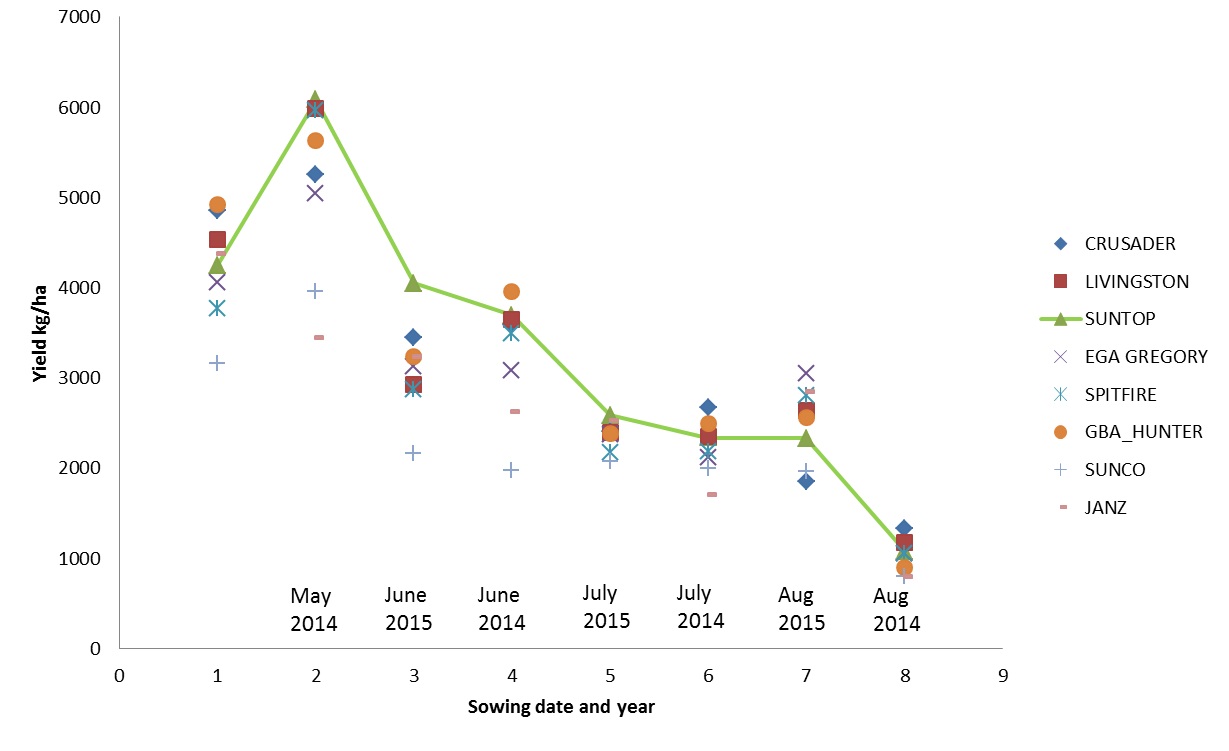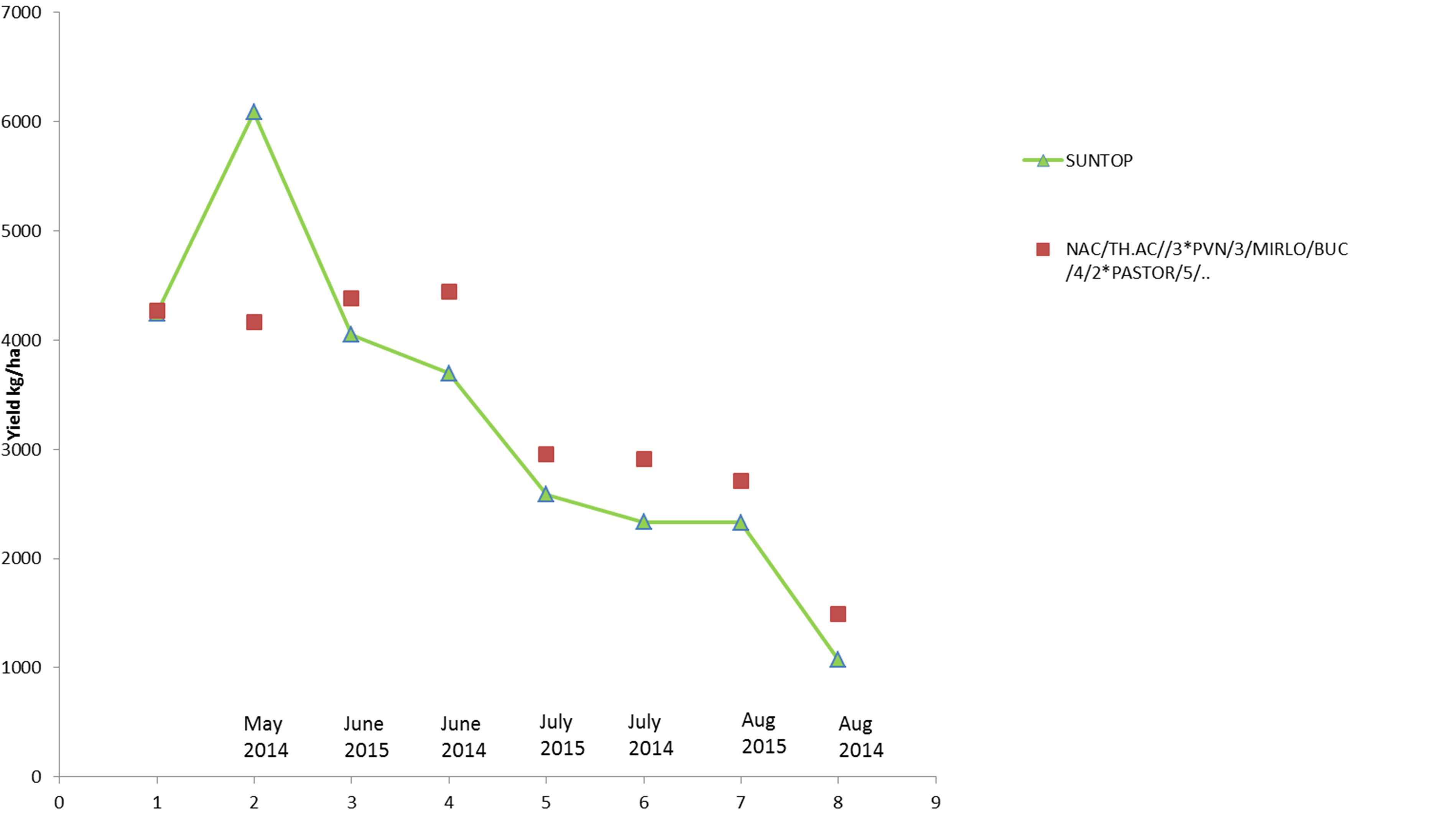The heat tolerance of some northern bread wheat varieties
Author: Richard Trethowan & Rebecca Thistlethwaite, IA Watson Grains Research Centre, The University of Sydney | Date: 01 Mar 2016
Take home message
Modern wheat varieties have a good level of high-temperature tolerance with newer varieties such as SUNTOP, SPITFIRE, GBA HUNTER, LIVINGSTON, and EGA GREGORY producing high yield when late sown. New sources of genetic variation with higher yield and lower screenings have also been identified for future breeding and selection to maintain genetic progress in the heat tolerance of wheat.
The University of Sydney’s IA Watson Grains Research Centre at Narrabri is researching the high-temperature tolerance of wheat with the support of the Grains Research and Development Corporation (GRDC). The aim is to identify and develop new genetic sources of heat tolerance that can be exploited by Australia’s commercial wheat breeding companies. Large numbers of new materials are screened in the field at Narrabri across dates of sowing between May and August each year. These data are augmented by field based heat chambers that are used to induce heat shock on selected materials. A range of Australian released varieties of relevance to the northern grains region are used as checks. These include SUNTOP, SPITFIRE, EGA GREGORY, GBA HUNTER, LIVINGSTON, CRUSADER and the older varieties SUNCO and JANZ.
Results indicate that most modern varieties already have high levels of high-temperature tolerance (Figure 1). However, several new genetic sources of variation for heat tolerance have been found that are competitive for yield when optimally sown but significantly superior when late sown including the line NAC/TH.AC//3*PVN/3/MIRLO/BUC/4/2*PASTOR/5/KAUZ//ALTAR 84/AOS/3/MILAN/KAUZ/4/HUITES/6/KAUZ//ALTAR 84/AOS/3/MILAN/KAUZ/4/HUITES developed by the International Maize and Wheat Improvement Centre (CIMMYT) and imported under the GRDC funded CAIGE project (Figure 2). Importantly, this line also has significantly reduced screenings compared to the modern northern cultivars when late sown (Table 1).

Figure 1. The yield of released cultivars across dates of sowing at Narrabri between 2014 and 2015
(Suntop, Spitfire, EGA Gregory, GBA Hunter, Livingston, Crusader in the graph above are all protected under the Plant Breeders Rights Act 1994.)

Figure 2. The yield of SUNTOP, and a new source of heat tolerance (NAC..) across dates of sowing at Narrabri in 2014 and 2015
Table 1. The yield and screenings of late sown varieties and new materials at Narrabri in 2015
|
Pedigree |
Yield kg/ha |
Screenings % |
|
JANZ |
2519 abc |
9.2 a |
|
DBW17//DBW17/18293 KC75 |
2412 abc |
9.5 a |
|
NAC/TH.AC//3*PVN/3/MIRLO/BUC/4/2*PASTOR/5/KAUZ |
2950 bc |
9.8 a |
|
SUNCO |
2073 a |
11.2 a |
|
WBLL1*2/BRAMBLING//QUAIU |
2607 bc |
11.9 a |
|
EGA GREGORY |
2365 ab |
12.7 a |
|
CRUSADER |
2398 abc |
15.3 ab |
|
KAUZ/PASTOR//PBW343/3/KIRITATI/4/FRNCLN |
2522 abc |
15.3 ab |
|
SUNTOP |
2585 abc |
21.0 cb |
|
LIVINGSTON |
2389 abc |
23.4 c |
|
GBA_HUNTER |
2375 abc |
24.0 c |
|
SPITFIRE |
2164 a |
25.0 c |
These new sources of genetic variation are different to current Australian varieties and are therefore potential new parents for Australian wheat breeders. Knowledge of the genetic control of tolerance is well advanced and the development of molecular markers to assist breeders with the introduction of this trait into locally adapted varieties continues.
Acknowledgements
The research undertaken as part of this project is made possible by the significant contributions of growers through both trial cooperation and the support of the GRDC, the author would like to thank them for their continued support.
Contact details
Richard Trethowan & Rebecca Thistlethwaite
The IA Watson Grains Research Centre (The University of Sydney)
Newell Hwy, Narrabri
Ph: 0400320558, 02 6799 2200
Email: Richard.trethowan@sydney.edu.au; rebecca.thistlethwaite@sydney.edu.au
GRDC Project Code: US00057,
Was this page helpful?
YOUR FEEDBACK
